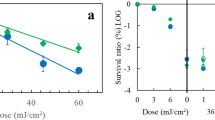Abstract
INCORPORATION of 5-bromodeoxyuridine (BUdR) into the DNA of bacteriophages, bacteria and mammalian cells results in highly increased sensitivity not only to short-wave ultra-violet light1–4 but also, and even more profoundly, to ‘visible’ light2,4 or more probably to its long-wave ultra-violet component. An attempt was made to determine the photochemical mechanism of this phenomenon, as a logical extension of our earlier work on the mechanism of short-wave (2537 Å) ultra-violet light effects on BUdR-labelled cells and transforming DNA5. It was suspected that photochemical dehalogenation, a reaction already observed with short-wave ultra-violet light6, accounts for most of the lethal effects of ‘visible’ light, especially of the 3000–3600 Å component. The experiments were performed either with intact cells or with protein- and RNA-free DNA isolated from genetically transforming strains of Bacillus subtilis. In a few experiments, a thymine-requiring strain of Escherichia coli, 15 T−, was also used. The growth conditions resulting in massive incorporation of BUdR were described earlier7. 5-Bromouracil labelled with carbon-14 was used to label the cell DNA for the chromatographic experiments. A fluorescent lamp (General Electric, warm-white, 20 W) served as the source of ‘visible’ illumination. (Prolonged irradiation of frozen thymine solution with this lamp results in formation of small quantities of the thymine dimer, indicating that a minute fraction of its spectral output is a photochemically active ultra-violet component, which otherwise would scarcely be detectable by the usual spectrophotometric procedures.)
Similar content being viewed by others
References
Kozinski, A. W., and Szybalski, W., Virology, 9, 260 (1959).
Greer, S., J. Gen. Microbiol., 22, 618 (1960).
Djordjevic, B., and Szybalski, W., J. Exp. Med., 112, 509 (1960).
Stahl, F. W., Crasemann, J. M., Okun, L., Fox, E., and Laird, C., Virology, 13, 98 (1961).
Szybalski, W., in Progress in Photobiology, edit. by Christensen, B. C., and Buchmann, B., 542 (Elsevier Pub. Co., Amsterdam, 1961); and in The Molecular Basis of Neoplasia, 147 (Univ. Texas Press, Austin, 1962).
Wacker, A., J. Chim. Phys., 58, 1041 (1961).
Opara-Kubinska, Z., Lorkiewicz, Z., and Szybalski, W., Biochem. Biophys. Res. Comm., 4, 288 (1961).
Beukers, R., and Berends, W., Biochim. Biophys. Acta, 49, 181 (1961).
Smith, K. C., Biochem. Biophys. Res. Comm., 6, 458 (1961–62).
Boyce, R. P., Ph.D. thesis, Yale University (1961).
Author information
Authors and Affiliations
Rights and permissions
About this article
Cite this article
WACKER, A., MENNIGMANN, H. & SZYBALSKI, W. Effects of ‘Visible’ Light on 5-Bromouracil-labelled DNA. Nature 196, 685–686 (1962). https://doi.org/10.1038/196685a0
Issue Date:
DOI: https://doi.org/10.1038/196685a0
- Springer Nature Limited
This article is cited by
-
The action of ultraviolet light on the patterns of banding induced by restriction endonucleases in human chromosomes
Chromosoma (1984)
-
Plants and near-ultraviolet radiation
The Botanical Review (1978)
-
Induction of Polyoma Virus by Fluorescent (Visible) Light in Polyoma-transformed Cells pretreated with 5-Bromodeoxyuridine
Nature New Biology (1973)
-
Light Inactivation of Focus Formation by Chicken Embryo Fibroblasts infected with Avian Sarcoma Virus in the Presence of 5-Bromodeoxyuridine
Nature (1970)
-
Protection and host cell repair of irradiated lambda phage
Molecular and General Genetics MGG (1969)





